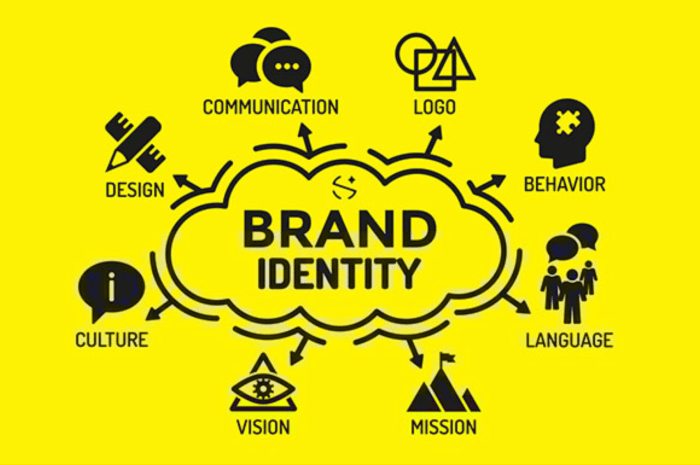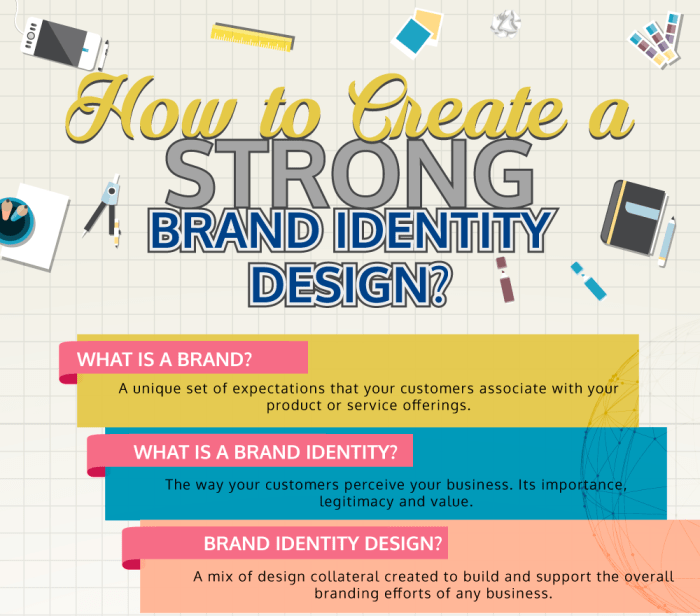Creating a Brand Identity sets the stage for your business to shine with individuality and charm, like the coolest kid in school turning heads. Get ready to dive into the world of branding where every element speaks volumes about who you are.
In this journey, we will explore the key components of brand identity, the development of brand personality, creating a visual identity, brand guidelines, and how brands evolve while staying true to their roots.
Importance of Brand Identity
Creating a strong brand identity is like setting the stage for your business to shine in a crowded room. It’s all about showing the world who you are, what you stand for, and why you’re the best choice out there. Let’s dive into why brand identity is crucial for businesses.
Brand identity is the secret sauce that helps set a company apart from its competitors. It’s not just about having a cool logo or catchy slogan; it’s about creating a unique personality for your brand that resonates with your target audience. When done right, brand identity can build trust, loyalty, and recognition among customers, making them choose your brand over others.
Setting Your Brand Apart
- Consistency is key: From your logo and colors to your tone of voice and messaging, consistency across all touchpoints helps customers recognize and remember your brand.
- Emotional connection: A strong brand identity can evoke emotions and create a lasting bond with customers, leading to brand loyalty and advocacy.
- Standing out in a crowded market: Brands like Apple, Nike, and Coca-Cola have built iconic brand identities that make them instantly recognizable and stand out in their respective industries.
Elements of Brand Identity

Brand identity is made up of various key components that work together to create a strong and memorable image for a brand. These elements include the logo, color palette, and typography, each playing a crucial role in shaping the overall identity of a brand.
Logo
Logos are the visual representation of a brand and are often the first thing people associate with a company. A well-designed logo can communicate the values, personality, and essence of a brand in a single image. For example, the Nike swoosh is instantly recognizable and represents the brand’s commitment to athleticism and innovation.
Color Palette
Colors evoke emotions and can have a significant impact on how a brand is perceived. A carefully chosen color palette can help create a cohesive and consistent brand identity. For instance, the vibrant red of Coca-Cola is synonymous with energy and excitement, while the calming blue of Facebook conveys trust and reliability.
Typography
Typography plays a crucial role in communicating the tone and personality of a brand through the style, size, and spacing of fonts. Brands like Apple use sleek and minimalist typography to reinforce their image of sophistication and simplicity, while Disney employs playful and whimsical fonts to appeal to a younger audience.
Brand Personality Development

Defining a brand’s personality involves identifying the characteristics, traits, and values that set the brand apart from others. It is essentially how the brand is perceived by its audience and how it connects with them on an emotional level.
Defining Brand Personality
To define a brand’s personality, start by identifying the brand values that form the foundation of its identity. These values serve as the guiding principles that shape the brand’s behavior and communication.
- Brand Voice: Determine the tone, language, and style of communication that the brand will use to convey its message. Whether it’s formal, friendly, humorous, or authoritative, the brand voice should be consistent across all touchpoints.
- Messaging: Craft a compelling narrative that communicates the brand’s values, mission, and vision. The messaging should resonate with the target audience and evoke the desired emotions and responses.
- Visual Identity: Choose colors, fonts, imagery, and design elements that reflect the brand’s personality. Consistency in visual elements helps reinforce the brand’s identity and create a memorable brand experience.
Tips for Developing Brand Personality
1. Know your audience: Understand the demographics, psychographics, and preferences of your target audience to tailor your brand personality to resonate with them.
2. Be authentic: Stay true to your brand values and voice to build credibility and trust with your audience.
3. Consistency is key: Ensure that all brand touchpoints, from marketing materials to customer interactions, reflect the same personality traits and values.
4. Evolve with feedback: Listen to customer feedback and market trends to adapt and refine your brand personality over time.
Creating a Visual Identity
Creating a visually appealing brand identity is crucial for capturing the attention of your target audience and standing out in a crowded market. A strong visual identity helps to communicate your brand’s values, personality, and messaging effectively. Here are some steps to create a visually appealing brand identity:
Importance of Consistency in Design Elements
Consistency in design elements across all brand materials is essential for building a strong and memorable brand identity. When your audience sees consistent colors, fonts, and imagery on your website, social media, packaging, and other materials, they are more likely to recognize and remember your brand. Consistency also helps to build trust and credibility with your audience.
- Use the same color palette across all brand materials to create a cohesive look and feel.
- Choose fonts that reflect your brand’s personality and are easy to read across different platforms.
- Select imagery that aligns with your brand values and resonates with your target audience.
Choosing Colors, Fonts, and Imagery
When selecting colors, fonts, and imagery for your brand identity, it’s important to consider how these elements will represent your brand and resonate with your target audience.
- Colors: Choose colors that evoke the emotions and associations you want to convey. Consider the psychological impact of different colors on your audience.
- Fonts: Select fonts that are easy to read and align with your brand’s personality. Different fonts can evoke different emotions, so choose one that complements your brand identity.
- Imagery: Use imagery that reflects your brand values and speaks to your target audience. Whether you use photography, illustrations, or graphics, make sure it aligns with your brand’s messaging.
Brand Identity Guidelines: Creating A Brand Identity
Brand identity guidelines are essential in maintaining a consistent brand image across all platforms and mediums. They serve as a set of rules and standards that ensure that the brand is represented in a cohesive and uniform manner, regardless of where it is displayed.
Components of Brand Identity Guidelines, Creating a Brand Identity
- Tone of Voice: Defines the language and style used in all brand communication.
- Logo Usage: Specifies how and where the logo can be used, including size, color variations, and placement.
- Color Palette: Establishes the primary and secondary colors that represent the brand.
- Typography: Sets guidelines for font styles, sizes, and spacing in all brand materials.
- Imagery Guidelines: Defines the types of images and graphics that are appropriate for the brand.
Best Practices for Enforcing Brand Guidelines
- Educate Stakeholders: Ensure that all employees, partners, and vendors are aware of the brand guidelines and understand the importance of consistency.
- Create Templates: Develop templates for various marketing materials to make it easy for everyone to follow the guidelines.
- Regular Audits: Conduct regular audits to check if the brand guidelines are being followed and make necessary corrections.
- Provide Resources: Offer resources such as brand assets, style guides, and training materials to support adherence to the guidelines.
- Centralize Communication: Establish a central point of contact for all brand-related inquiries and updates to avoid confusion.
Brand Identity Evolution
In the fast-paced world of business and marketing, brands often need to evolve their identities to stay relevant and competitive. However, it’s crucial to do so in a way that maintains brand recognition and loyalty among customers.
Strategies for Brand Evolution
When it comes to rebranding or refreshing a brand’s identity, there are several strategies that companies can employ to ensure a successful transition:
- Conduct thorough market research to understand current trends and consumer preferences.
- Involve key stakeholders, including employees, customers, and partners, in the rebranding process to gain valuable insights and buy-in.
- Create a clear and compelling brand story that communicates the evolution while staying true to the brand’s core values.
- Roll out the new brand identity gradually, starting with internal stakeholders before unveiling it to the public.
Successful Brand Identity Evolutions
Several brands have successfully evolved their identities over the years, adapting to changing market dynamics and consumer expectations. One notable example is Apple, which transitioned from a niche computer company to a global tech giant by rebranding itself as a lifestyle brand focused on innovation and design.












